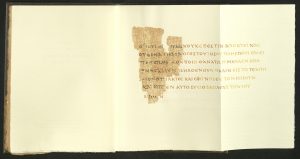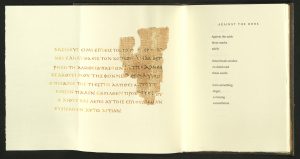Tags
Bernard Grenfell, California, calligraphy, Cave, codex, David Annwn, Egyptian, English, Foolscap Press, Frankfurt Cream, Gospel of John, Greek, Hadrian, Hadrianic, leaves, Mark Knudsen, paper, papyrus, pochoir, poem, Roman Emperor, Saint John, Saint John's Fragment, Santa Cruz, script, scroll, sheet, stencils, Thomas Ingmire, Tiepolo, translation
a King I am. For this I have been born
and I have come into the world so that I would
testify to the truth. Everyone who is of the truth
hears of me my voice.” Said to him
Pilate “What is truth?” and this
having said, again he went out unto the Jews
and said to them,” I find not one
fault in him.”
–translation of a fragment of St. John’s Fragment
The Saint John’s Fragment: Against the Odds
David Annwn
Santa Cruz, CA: Foolscap Press, 2015
PR6051 N615 S3 2015
Poem inspired by the St. John’s fragment, a papyrus fragment now in the collection of the Rylands Library at the University of Manchester (Rylands Library Papyrus P52), dated between 100 and 150 CE and thought to be the earliest extant manuscript of a New Testament text.
From the Afterword: “The piece of papyrus called the St. John’s Fragment was acquired in an Egyptian market in 1920 by Bernard Grenfell, an English scientist and Egyptologist…
Written on both sides of the papyrus, it must have been part of a a codex, that is, a collection of sewn and folded leaves, not a scroll or an isolated sheet. That being the case, it would be among the earliest surviving examples of a literary codex. It was written in Greek in a script known as Hadrianic, named after Hadrian (76-CE – 138 CE), the Roman Emperor of the time…
Specifically, the text on this piece of papyrus is from the Gospel of John 18:31-33 and the verso holds a snippet of verses 237-38…”
From the colophon: “Thomas Ingmire’s calligraphy shows the image of the actual Fragment, then the restored page, then the English translation of the restored page. Mark Knudsen made the stencils for the pochoir painting of the Fragment. The poem is printed in Tiepolo type to complement the Fragment…The book is printed on Frankfurt Cream and bound in Cave paper.” Edition of one hundred and sixteen copies. Rare Books copy is no. 41, signed by the poet and the calligrapher.



You must be logged in to post a comment.